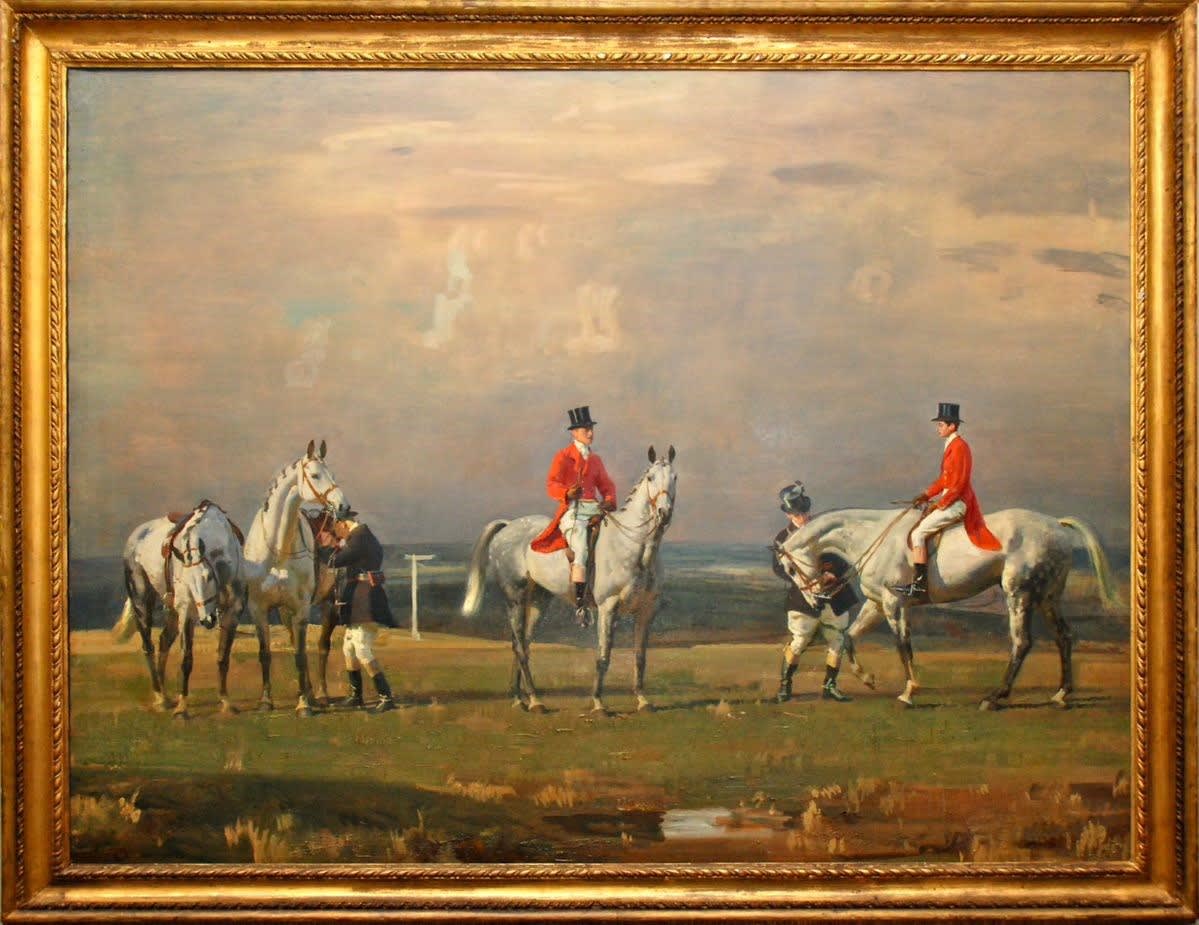-
'Beyond All Dreams': Sir Alfred Munnings at Blenheim
'Four Grey Horses: Studies of The 9th Duke of Marlborough and Lord Ivor Spencer-Churchill' -
On 6 November 1895, at Saint Thomas Church in New York City, Charles Spencer-Churchill, 9th Duke of Marlborough, married the American railroad heiress Consuelo Vanderbilt. She was one of many so-called ‘Dollar Princesses’ who married into the English aristocracy – so often an exchange of wealth for title. Her mother had long held the ambition to see her daughter made a Duchess, and the Duke is alleged to have unromantically, though candidly, told his new bride on their honeymoon that he had married her to 'save Blenheim'. He applied the Vanderbilt dowry to the restoration and refurbishment of Blenheim palace, the grandeur of which had a marked impression on Munnings during his period painting the commission of the Duke and his younger son, Lord Ivor:
‘The grooms and horses were painted at Blenheim. A memorable visit. A palace beyond all dreams. Entrance hall and staircase, faded flags, trophies of victories and pictures by Reynolds and Sargent on either side, were a mere beginning of what followed…The stables, too, all in the same grand style. What noble courtyards, where I stood in cool shadow, wearing my soiled old painting-coat, with easel, canvas and paint-box, ready for the fray'. -
 John Singer Sargent (1856–1925), Portrait of the 9th Duke of Marlborough with his family, 1905 (Blenheim Palace), image in the public domain.
John Singer Sargent (1856–1925), Portrait of the 9th Duke of Marlborough with his family, 1905 (Blenheim Palace), image in the public domain. -
 Giovanni Boldoni (1842-1931), Consuelo Vanderbilt (1876–1964), Duchess of Marlborough, and Her Son, Lord Ivor Spencer-Churchill (1898–1956), 1906 (The Metropolitan Museum of Art), image in the public domain.
Giovanni Boldoni (1842-1931), Consuelo Vanderbilt (1876–1964), Duchess of Marlborough, and Her Son, Lord Ivor Spencer-Churchill (1898–1956), 1906 (The Metropolitan Museum of Art), image in the public domain. -
Munnings admired the poise and beauty of Lord Ivor, who was a fine rider and patron of modern French art. He painted both Lord Ivor and the Duke in his Glebe Place studio, describing the son in his autobiography: 'no costumed figure could beat the one sitting on the saddle-horse: slim, with long, slim legs, long, flesh-coloured tops to his shining boots – the cut-away coat, perfection!’.
The artist indulged in these features on the reverse of the study, capturing his sitter’s likeness and the ease with which he sits in the saddle. At the start of the First World War, Lord Ivor failed to pass the medical tests for the army and so worked at the War Office. Nonetheless, his cousin Winston Churchill took him with him on one of his tours of inspection of the front in France. Lord Ivor died of an inoperable brain tumour at the age of 57 and his mother chose to be buried beside him at St Martin's Church, Bladon, where Churchill was also buried months later.
-
Munnings lamented the fact that he did not spend longer on this commission, missing the opportunity to produce more work from what he viewed as the ideal object of his creative inspiration. He wrote:
‘Fancy could take flight in such a setting. […] Looking back on those days of hurry and too many portraits, and thinking of this Blenheim picture, I ask myself a question: why, instead of taking two months, did I not take two years to complete the Duke’s conception of scarlet-coated figures and grey horses? Why not do it again and yet again? It was worth it'.
This study thus stands not only as a fascinating record of Munnings’ artistic process, but also represents a commission which for him epitomised the beauty to be found in English horses, aristocracy, and the countryside. Situated in the legacy of the American Gilded Age and the last days of the old social order in Britain, forever altered by the First and Second World Wars, it captures fascinating individual and social histories as well as the perspective of an inspired artist, operating at his peak.
By Lydia Gascoigne, Gallery Specialist
-
 The final painting, with thanks to Blenheim Palace for providing us with this image.
The final painting, with thanks to Blenheim Palace for providing us with this image. -
Bibliography
Sir Alfred Munnings, The Second Burst (London: Museum Press, 1951), pp. 156-7
Amanda Mackenzie Stuart, Consuelo and Alva Vanderbilt: the story of a daughter and a mother in the Gilded Age (New York, NY: Harper Collins, 2005)
Consuelo Vanderbilt, The Glitter and the Gold (New York, NY: Harper Brothers, 1952)



